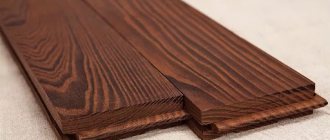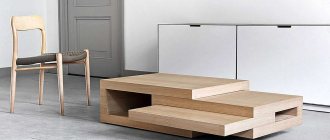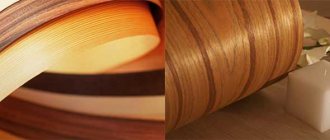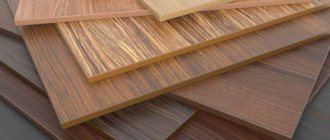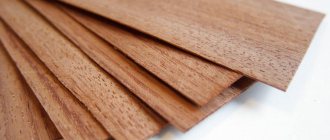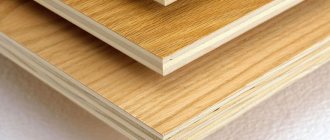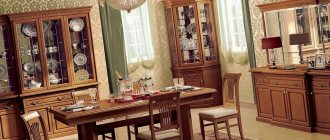Over the last ten years in Russia, the demand for massive, solid furniture, the main elements of which are slabs with a thickness of 32-60 mm, has increased significantly. Interesting design and original aesthetics have ensured rapid growth in popularity for such products. However, until recently, the technological capabilities of domestic production could not meet the new needs for furniture. Firstly, there were difficulties with the high cost of such products, and secondly, old technologies made it possible to make such furniture too massive and heavy, which put a significant load on the walls and ceilings.
A solution to this problem was found in Europe in the early 2000s, through the development and subsequent mass production of a new material - tambourate. At first, furniture made from it was as expensive as analogue models made from traditional materials: chipboard and wood. In Russia, such models were even more expensive. However, the development of production capacity and the availability of this material for factories with average production capacity have made it possible to reduce the retail price of the increasingly popular, prestigious and stylish tambourate furniture.
What is tamburat? History of appearance and development
Tamburat is frameless lightweight slabs with three separate layers. External layers - chipboard, MDF, plywood, etc. thickness from 3 to 8 mm, and the inner layer is a honeycomb paper and cardboard filler.
Just 10 years ago, the share of 40 mm furniture elements and countertops in our market had a very small share, no more than 12%, the rest were produced up to 28 mm thick. At the moment, the share of 40 mm (or more) furniture elements has grown significantly and is about 40%, especially for countertops. The current situation is pushing furniture manufacturers to search for new non-standard solutions, one of them - slabs with honeycomb core, called "Tamburat" in Russia - is offered as an anti-crisis material in the face of increased furniture competition. Furniture using tambourate today is a stylish, respectable option for home, office and commercial interiors.
The appearance of tambourate materials in the 2000s was a real pleasant surprise for manufacturers of cabinet furniture and interior items. Tamburat made it possible to reduce the cost of furniture with thick slab materials, and at the same time significantly reduced the weight of the furniture itself. Thanks to these plates, it was possible to establish in-line production of previously exclusive models, making them available to a wide consumer audience.
Furniture made from solid tambourata to order
Products made from high-quality veneered tambourate are not inferior to wooden furniture in terms of reliability and beauty, and often surpass it in design. Having sufficient length and width, Eurolight panels allow you to realize any design idea in creating furniture for home and office.
In the production of custom-made vestibule furniture, laminated chipboard is often used to make internal walls and partitions - this helps reduce the cost of products.
At the same time, the furniture meets demanding demands regarding functionality and style: open parts look massive and presentable, and the internal contents of closed areas do not affect the appearance in any way.
Main characteristics and advantages of tambourate
Despite its low weight and the small amount of raw materials used in its production, tambourate has very high strength and thus makes a real revolution in the field of furniture design and interior decoration.
What can be attributed to the main characteristics of tamburat? The thickness of the vestibule can be from 32 to 100 mm, most often 50 – 60 mm. When the thickness is more than 100 mm, an embedded strip is required - a block of solid chipboard or wood inside the vestibule, which greatly simplifies the process of making furniture from cellular slabs. The shape of the vestibule slab can be either straight or curved. And the maximum size of the slab is usually 2440 * 1240 mm. The thickness of the front layers varies from 3 to 8 mm (sometimes more). This can be laminated chipboard, plywood, MDF and other material. Plus there is also additional lining with plastic, film, etc. Honeycomb core usually has hexagonal-shaped cells. It is a complex structure consisting of at least two materials - paper (cardboard) and glue. It follows that, with equal geometric parameters, the physical and mechanical properties of the filler significantly depend on the properties of the paper and glue
Solid facades made of veneered vestibule
Eurolight panels lined with veneer cannot be distinguished from natural wood. They are able to maintain their rigid structure and hold fasteners perfectly. Massive in appearance, tambourate furniture is light, long slabs do not deform under their own weight. Thanks to the cellular “filling”, the material has good heat and sound insulation, and high bending strength allows the production of thicker parts.
The main advantages of tambourate are:
- Light weight;
- High strength;
- Dimensional stability;
- High load-bearing capacity;
- Versatility in use;
- Durable, not subject to aging.
- Resistant to temperature changes and indoor humidity levels.
- Sound insulation, thermal insulation.
- Made from environmentally friendly materials, not harmful to health.
- Low cost.
Thanks to all these qualities, tambourate allows the production of large and not bulky furniture that perfectly retains its original shape and is not subject to deformation under its own weight.
The low weight of the material helps save on furniture manufacturing time and labor. It is more convenient to work with lightweight materials. The tamburat is easy to move from place to place, as well as raise it to a height. This also saves on material transportation. Thanks to its structure, which includes a honeycomb filler, the board has excellent bending resistance. At the same time, tamburate is easy to process. Plates with outer layers of 8 mm, as a rule, do not require any special fittings. It is also worth noting the high environmental safety of tamburat. To make a tambourate, 60% less wood is required than to make chipboard. Another undeniable advantage of the vestibule is the ability to integrate electrical appliances and equipment. Thanks to the sandwich-type structure of the boards, all cabling can be done in the middle layer of the board - the honeycomb core. Lighting, outlets, chargers, speakers and even iPod docking stations can be built into the core of tambourate materials. This opens up many new design options.
Pros and cons of tambourate or furniture board
The popularity of using furniture boards is due to the large number of undeniable advantages that tambourate has.
Tamburat is easy to process. It is easy to saw, cut, paint, and install. Working with furniture boards does not require any special tools or accessories.
The furniture board has high strength and can withstand very high loads
Compared to solid wood, tamburat is light in weight. It is easy to transport and work with. The furniture is also easier to use
The presentable appearance of furniture made from furniture boards is very similar to solid natural wood. At a glance, even experienced craftsmen do not always distinguish which furniture is made of solid wood and which is made of furniture board.
Low cost is the most important advantage of furniture boards. Any consumer can afford tambourate furniture
- Furniture made from such material will last a very long time. Because it is highly resistant to external influences and wear
- Tamburat is easy to paint. In addition, it is produced in various color variations. A practical choice for every taste.
- The structure of the furniture board allows you to hide various wires in it
Features of tambourate processing
Like any other innovative product, lightweight furniture tambourate boards have their own nuances in processing throughout the entire technological process chain for the production of furniture parts. When cutting tambourate into formats, it is necessary to take into account the fragility of the material itself and the specific strength of the strength near the ends. Equipment is needed that does not create pressure on the slab during processing, for example, it could be formatting machines with a movable carriage. When the thickness of the outer layers of the tambourate is 8 mm or more, the pressure during cutting is the same as for conventional chipboard. Another difficulty is the edgebanding of finished tambourate products. Optimal for edging would be tambourate material with a thickness of outer layers of 8 mm, because adhesion at this thickness will be sufficient to hold the edge on the product. It is necessary to take into account the fact that the center of the edge falls on the void of the slab, so you need to use only thick edge materials, which, due to their rigidity, prevent subsidence into the slab. There are certain recommendations: for a slab with a thickness of 38mm, the minimum edge thickness is 1.5-2mm, for a thickness of 50mm - 2mm, for a thickness of 60mm - 3mm. It is only possible to use an edge with a thinner thickness when using embedded strips or a supporting edge.
An additional nuance of tambourate processing for a furniture manufacturer may be the installation of embedded strips in the slab. These can be bars made of wood, MDF or chipboard, etc. The laying of the end strips occurs by milling the quarter in the outer layers to a depth corresponding to the parameters required in the design of the embedded parts, and gluing the strips into the quarter. To speed up the curing of the glue, the operation is performed on a press.
To improve the aesthetics of a number of products, inserts are made into tambourate panels using other materials. Glass and acrylic plastic are mainly used for these purposes. The presence of a variety of decorative corners and MDF profiles allows such integration to be carried out accurately, thanks to which the places where decorative elements are inserted look great even up close. Most often, this is more clearly visible in modern interior doors.
Furniture fittings in the MDM assortment for vestibules
Companies developing and producing accessories have not remained aloof from this process. Entire lines of special accessories for vestibules have been created. Below we will talk about components used in furniture made from standard materials, which can also be used in products made from vestibule.
For vestibule without embedded strips and outer layers of 3mm and 4mm
- Shelf supports KAIMAN and KAIMAN MAXI (depending on the thickness of the vestibule)
For vestibule with embedded strips from 30mm thick and outer layers 3mm and 4mm
Ties
- Confirmat (for connecting embedded slats and depending on the thickness of the vestibule)
- Shelf tie (including FLIPPER and PK2)
- Conical tie (for thickness 30mm)
- Intersectional coupler (for connecting embedded slats and depending on the thickness of the vestibule)
- Furniture corner
- Dowel (for connecting embedded slats)
Shelf supports
- Without fixation
- With fixation (including UNICO, SPRING)
- TRIADE XXL
- KAIMAN and KAIMAN MAXI (depending on the thickness of the vestibule)
- Decorative shelf holder
Loops
- Standard four-joint hinges
Application area
Being a universal material, tamburate is suitable for the production of almost any furniture that can be used in home, office, retail, municipal and educational premises. This could be kitchen units, all cabinet furniture, shelving structures of all types, wall shelves, children's furniture, reception desks, catering furniture, etc. Massive furniture in large spacious rooms looks much more organic than its conventional 16-25 mm counterparts. laminated chipboards. In addition, due to their excellent soundproofing properties, vestibule panels can be used for zoning space and constructing interior partitions, including sliding ones.
A wide range of cladding slab decors ensures compatibility of vestibule furniture with interiors decorated in any style. And the possibility of applying matte, semi-matte or glossy varnish to the veneered surface allows manufacturers to produce luxury premium furniture. There are two options for producing furniture using tambourate material. In the first case, light boards are partially used in furniture, which makes it possible to gradually master manufacturing technology, minimally change the production process and expand the range of furniture collections. For example, lightweight slabs can only be used in those elements that first catch the eye. In the second case, the furniture is made entirely from light slabs. Everything in it, even the shelves, is made of vestibule. This method, of course, changes the production process as much as possible, but the manufactured furniture exceeds all expectations!
Material advantages
The idea of boards with a honeycomb structure was proposed back in 1943, but only 20 years later it was implemented in the furniture industry. The next step for manufacturers is to select a filler for this material, and soon a tambourate with a honeycomb of compacted cardboard will be created.
Tamburat was just starting to gain popularity . This is due to the properties of the material. The advantages of these slabs are their hollow design.
Advantages:
- Ease of processing: tambourate is easy to cut with any tool; parts of various shapes and complexity can be made from it.
- Possibility of hidden installation, since the cardboard core of the slab allows you to construct hidden wiring and hide fasteners inside the slab. Furniture made from vestibule does not lose its appearance and gains functionality. Hidden wiring is convenient in the production of computer tables or office furniture.
- Fastening materials. Accessories for tambourate have the same properties and design as similar raw materials. Selecting fasteners will not cause difficulties. However, the thinnest sheets require the use of built-in fittings, which must be ordered from specialists. The uniformity of fasteners makes it possible to fasten tambourate with other more common materials, for example, chipboard or laminated chipboard.
- Strength. Honeycombs made of thick cardboard help the tamburate to withstand fairly high pressure in the horizontal plane without noticeable deformation. Vertical loads allow sheets to be bent without losing their original rigidity and strength. Because of this feature, thin tambourate is often used in the manufacture of convex structural elements.
- Choice of coatings. Popularity has allowed manufacturers to launch the production of many types of coatings. Products made from this material are available in any color, which is taken into account when decorating interiors.
- Light weight. The external dimensions of the vestibule do not coincide with the mass of the slabs. In this regard, the material has properties that allow it to be used in large-scale structures, the fragments of which can be easily moved.
- Price. Tamburat is one of the most affordable materials in its category. It is difficult to find a similar ratio between price and functionality of the panel. Products made from these boards are several times cheaper than others, and the level of quality and wear resistance of the finished product remain high.
Accessories for vestibule
Accessories for vestibules are divided into standard and special. When using a vestibule with embedded strips and front panels from 8 mm, it is possible to use almost any standard fittings that are suitable for chipboards. Special fittings for vestibules are primarily used with a thickness of outer layers of less than 8 mm, but they can also be used with vestibules with external layers of 8 mm to ensure additional reliability of the product. The main requirements for it are as follows: it must ensure the connection of slabs with a honeycomb filling, which should not break or sag, and also ensure high-quality fixation of fittings on fairly thin front panels and the fixation of thick shelves made of vestibule. The cost of fittings for cellular panels exceeds the cost of standard fittings. This is due to an increase in the amount of raw materials used in the production of fittings, with the use of new technologies, which are indispensable when working with tambourate and which must be repaid, as well as with the non-mass production of fittings. Many leading manufacturers and suppliers of fittings have tambourate fittings in their range. These are mainly fasteners designed for fastening parts made of lightweight slabs. Such fittings allow you to compensate for voids in the honeycomb filling of the slab.
The complexity of the process of joining tambourate parts is the use of specially designed furniture fittings, which make it possible to compensate for the voids in the honeycomb filling of the slab.
What is tamburat and what are its features?
Tamburat (honeycomb panel or sandwich panel) is a lightweight furniture and decorative panel with a thickness of 15 mm to 240 mm (the most common thicknesses: 24 mm - 120 mm). Honeycomb cells provide high stability of the panel due to their rigid structure: between two sheets of panel (chipboard, MDF, HDF, plywood) there is a layer of kraft cardboard (corrugated paper), reminiscent in its structure of a honeycomb.
It is impossible not to note the advantages of tambourate panels in furniture production:
- The visual effect of thick-walled structures made of natural wood undoubtedly has additional marketing advantages when selling vestibule furniture. The furniture looks unusual and attractive.
- The “free geometry” of the panel in thickness and curvilinearity make it possible to realize absolutely fantastic design possibilities that are not available when using panel materials (MDF and chipboard). Panels made of tambourate, used in conjunction with traditional materials (solid wood, chipboard, MDF) give the furniture a very respectable and expensive look.
- Unlike a solid slab, tambourate is extremely light, so it is not subject to deformation under its own weight. As a result, even long slabs up to 3 meters can withstand significant loads without additional supports.
You can also note excellent sound and heat insulation , environmental friendliness , and low cost .
When producing furniture from vestibule, the question undoubtedly arises as to what fittings can be used for this type of panel. To do this, you need to decide on the types of tambourate:
- Frameless slab
- A slab with embedded strips (slats) installed along the length of the slab on both sides of the slab. Available already cut according to the manufacturer's standard format. Some manufacturers also offer tambourine with embedded strips and a supporting edge. The standard thickness of embedded strips varies from 10mm to 70mm (this thickness can vary upon customer request).
- A slab with embedded strips (slats) around the perimeter of the slab (slab with frame) . It is offered already cut according to the manufacturer’s standard format using door technology with a perimeter lining, which involves the production of specific standard sizes of parts, as well as custom-made with embedded elements of any size according to technical specifications.
Application of tambourate for furniture production
There are two main methods for producing tambourate furniture.
- In the first case, light boards are partially used in furniture. This makes it possible to gradually master manufacturing technology, minimally change the production process and expand the range of furniture collections. In particular, lightweight boards are used in those elements that first catch the eye.
- In the second case, the furniture is made entirely from light slabs. Everything in it, even the shelves, is made of vestibule. Naturally, this method will require changing the production process as much as possible, but the results obtained exceed all expectations. This method makes it possible to offer customers fundamentally new collections, which has a positive effect on the competitiveness of the manufacturer.
